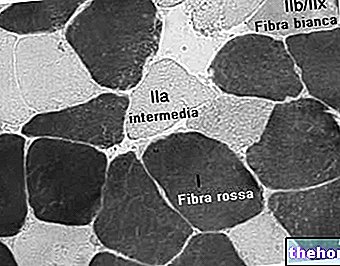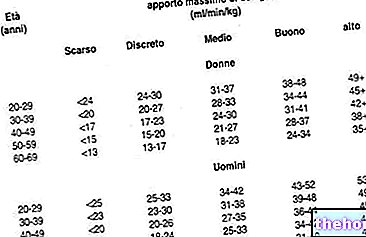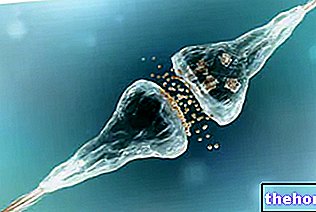"Plasma proteins
Synthesized by the parenchymal cells of the liver, albumin has an average life of 20 days. It is responsible for 80% of the oncotic pressure (colloid-osmotic) of the blood and as such favors the passage of water from the interstitial fluid to the capillaries (too much albumin exaggeratedly increases the volume of the blood, a deficiency instead leads to edema due to the accumulation of liquids in the intercellular spaces). It also acts as a reserve of amino acids, contributing significantly to the homeostasis of the most important proteins.
This very important and multifaceted plasma protein also has a transport function (steroid hormones, bilirubin, drugs, uric acid, calcium, free fatty acids, some vitamins).
INCREASES: phenomena of dehydration (vomiting, diarrhea, excessive physical activity, Addison's disease, etc.).
DECREASES: inadequate intake (malnutrition, malabsorption); decreased synthesis (liver disease: cirrhosis); exogenous losses (kidney disease, changes in the intestinal mucosa, burns); increased catabolism (hyperthyroidism).
Liver and lymphoid tissue
They are divided into three fractions: α, Β and γ. The first two cover transport functions, while the third includes the immunoglobulins involved in the body's defense processes (antibodies produced by plasma cells).
Alpha-1-globulins: increase in pregnancy, during treatment with oral contraceptives and in the course of various morbid conditions of inflammatory or traumatic origin; a decrease may be present in a severe pulmonary compromised condition called emphysema.
- α1-antitrypsin: inhibits serine proteases (trypsin, collagenase), has the ability to protect tissues from enzymes produced by inflammatory cells, especially elastases. Increase: inflammatory processes, necrosis, neoplasms. Decrease: genetic defect, liver cirrhosis, childhood respiratory defects.
- α1-acid glycoprotein: acute phase protein of inflammatory processes; increases in acute and chronic inflammatory processes, in case of wounds, burns and tumors; decreases in the presence of liver failure or malnutrition.
- α1-lipoprotein: carries fat-soluble vitamins, steroid hormones, lipids, better known as HDL cholesterol; it tends to increase in those who practice physical activity, an increase in it is considered a positive factor; on the other hand, it tends to decrease in smokers and sedentaries.
The alpha-2-globulins increase in the presence of particular diseases, such as infections, especially chronic, heart attacks, tumors, widespread collagen diseases, trauma and burns, diabetes. Therefore, the increase in a-2-globulins is of great clinical significance, but necessarily, like the ESR, it must be considered as a non-specific index of disease, which will therefore be sought with more specific and detailed investigations. An isolated decrease in a-2 - globulins are generally not of diagnostic importance.
- Haptoglobin: binds free hemoglobin present in the circulation to transport it to the endothelial reticulum system; increases during acute and chronic inflammatory processes, neoplasms and nephrotic syndromes; decreases in the presence of genetic defects, decreased synthesis (hepatopathies), haemolytic anemia and valve prostheses .
- Ceruloplasmin: responsible for the transport of copper in the blood; increases in copper intoxication, during pregnancy, in women taking estrogen or combined oral contraceptives (estrogen plus progesterone), in neoplastic pathologies and in acute and chronic inflammatory states, in leukemias, in Hodgkin's lymphomas, in primary biliary cirrhosis, in cholestasis, Alzheimer's disease, systemic lupus erythematosus and rheumatoid arthritis. It drops to pathological levels in some hereditary genetic diseases, such as Wilson's or Menke's and in ceruloplasminemia; it is also low in malnutrition and in all those conditions that determine reduced synthesis or increased loss of proteins (advanced liver disease, malabsorption syndrome, kidney disease such as nephrotic syndrome).
- Alpha-2-macroglobulin: non-specific inhibitor of plasma proteases and transporter of hormones, such as GH and insulin; increases in childhood and senescence; it has no great diagnostic significance, but characteristically rises in the nephrotic syndrome, since - by virtue of its high molecular weight - it is not filtered by the glomerulus.
- Alpha-2-lipoprotein: transports lipids.
B-globulins increase, even considerably, during pregnancy, since the rate of transferrin increases, and in some cases of abnormal presence of fats (cholesterol, triglycerides, phospholipids), as well as in other diseases, such as diabetes, hypothyroidism, hepatobiliary impairment (changes in which there is an increase in the fatty part of the bile).
- Transferrin - carries iron in the blood; it increases in iron deficiency anemias, in the administration of estrogens and decreases during liver disease, nephrotic syndromes, toxic and infectious states, neoplasms.
- β-lipoproteins: transports glycerides and other lipids.
- C3: complement protein that is activated when the body recognizes the presence of bacterial cells or immune complexes. It increases during autoimmune diseases, inflammations and chronic infections. It decreases in the presence of liver disease, kidney disease, autoimmune hemolytic anemia and other pathologies.
Gamma-globulins have antibody function; there are 5 classes: IgG, IgM, IgA, IgD, IgE. IgG are the most important share and represent 80% of all gamma-globulins.

- IgG; neutralization toxins, precipitation, secondary immune response (when the organism has already encountered the antigen previously), placental passage (neonatal immunity).
- IgA: participation, neutralization of viruses, protection of mucous membranes from local infections.
- IgM: agglutination, hemolysis, viral neutralization, primary immune response, rheumatoid factor
- IgD: neutralization of viruses.
- IgE: homocytotropism, anaphylaxis, allergy.
Fibrinogen is a large plasma protein that is involved in the blood clotting process. Not being part of the serum, it is not found in the electrophoretic trace of proteins. Its concentrations increase during inflammatory processes of any origin, in recovery from surgery and during pregnancy; on the other hand, they decrease due to hereditary disorders, severe liver diseases (reduced capacity for hepatic synthesis) and disseminated intravascular coagulation (due to excessive consumption due to the presence of numerous thrombi).
Plasma atherogenicity index
















.jpg)











